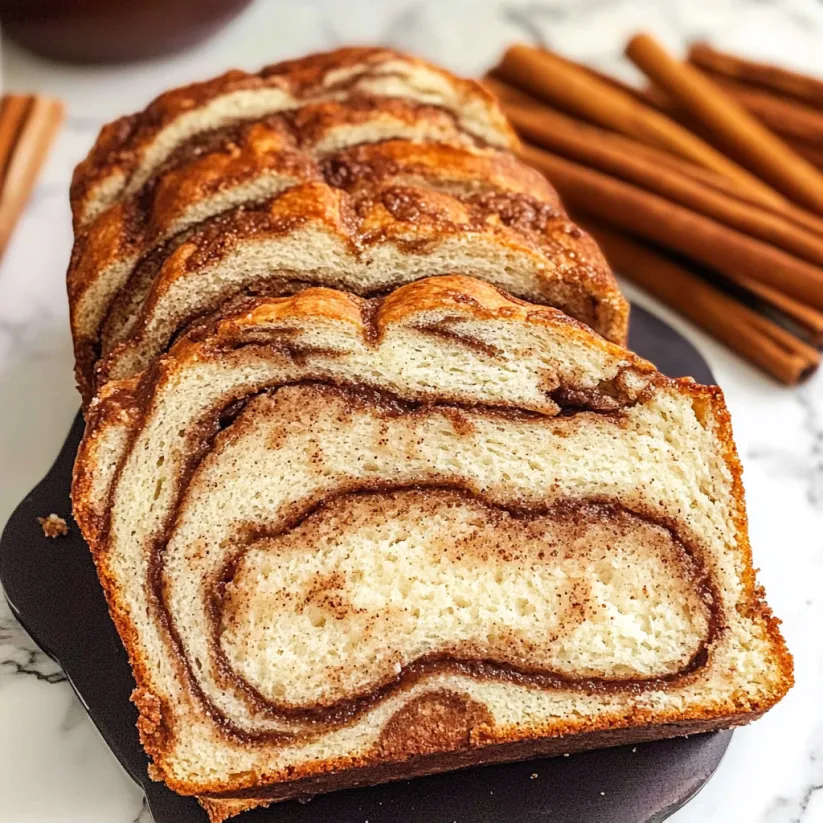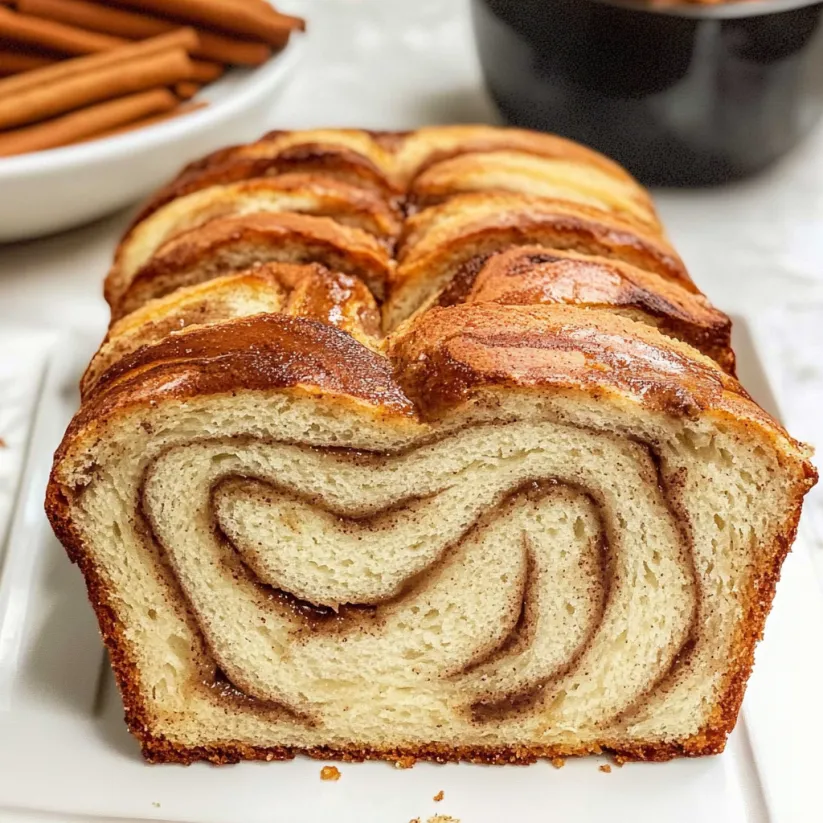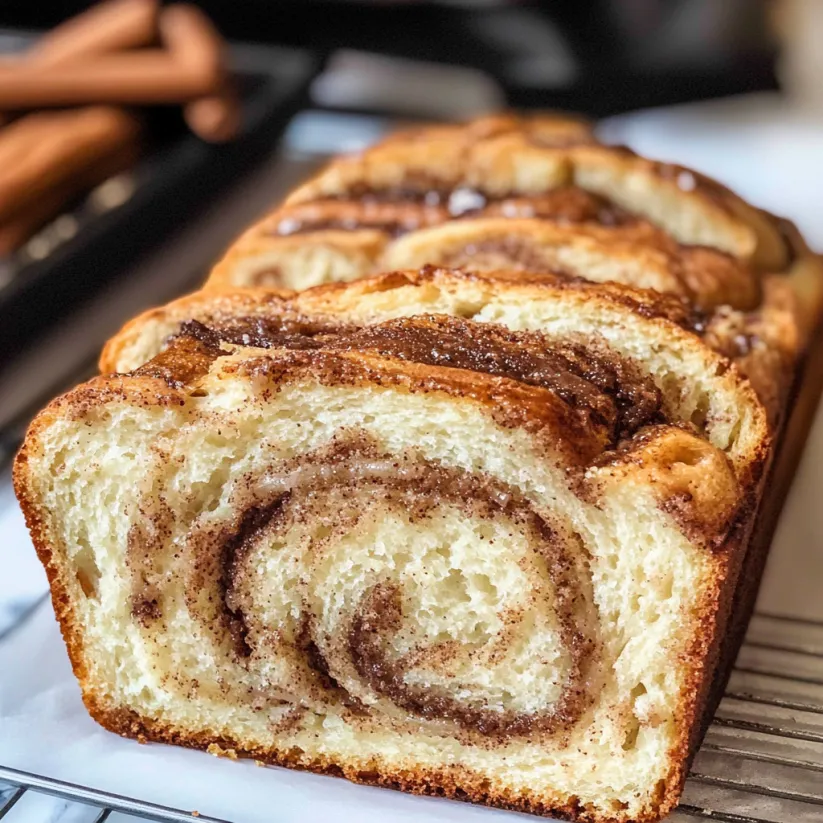 Save Pin
Save Pin
This homemade Cinnamon Bread delivers gorgeous swirls of cinnamon sugar in every slice, making it the perfect breakfast treat. Using just a handful of basic ingredients, this recipe yields a deliciously soft loaf that will fill your home with the most inviting aroma as it bakes.
I first made this cinnamon bread during a cold winter weekend when my family was craving something special for breakfast. The moment I pulled it from the oven, everyone gathered in the kitchen, drawn by the irresistible scent. Now it's our Sunday morning tradition.
Ingredients
- Milk provides moisture and activates the yeast for a perfectly risen loaf
- Butter adds richness and creates a tender crumb texture
- Active dry yeast serves as the leavening agent that helps the bread rise beautifully
- Eggs contribute structure and richness to the dough
- Sugar sweetens the bread and feeds the yeast for proper fermentation
- Vanilla extract enhances the overall flavor profile and complements the cinnamon
- All-purpose flour forms the structure of the bread look for unbleached for best flavor
- Salt balances the sweetness and strengthens the gluten network
- Cinnamon creates the signature flavor use fresh cinnamon for the most vibrant taste
- Extra egg for brushing creates that beautiful golden crust
Step-by-Step Instructions
- Prepare the Yeast Mixture
- Add milk and butter to a saucepan and warm over medium heat until butter melts and temperature reaches around 105°F not hotter or you risk killing the yeast. Sprinkle yeast over the mixture, whisk gently, and let rest for 10 minutes until foamy and activated.
- Create the Egg Base
- In your mixer bowl, combine eggs, sugar, and vanilla extract. Beat until light and fluffy using the whisk attachment. This creates an airy base that will contribute to the bread's soft texture.
- Combine Wet and Dry Ingredients
- Mix flour and salt in a separate bowl. Add the yeast mixture to the egg mixture and blend well. Switch to the dough hook attachment, add half the flour, and mix until combined. Add remaining flour and continue mixing for 5 minutes until the dough is smooth and elastic.
- First Rise
- Transfer the dough to an oiled bowl, cover with plastic wrap, and place in a warm spot. Allow it to rise until doubled in size, approximately 1 hour. The dough should look puffy and when poked gently with a finger, the indentation should remain.
- Shaping the Loaf
- Grease your loaf pan thoroughly. On a floured surface, roll the dough into a rectangle slightly wider than your loaf pan and about ¼ inch thick. Mix cinnamon and sugar together and spread evenly across the entire surface, leaving a small border at the edges.
- Creating the Swirl
- Roll the dough tightly from one short end to the other, creating a log. Pinch the seam and ends closed to seal in the filling. Place the loaf seam side down in your prepared pan.
- Second Rise
- Let the shaped loaf rise again until doubled in size, about 1 hour. This second rise creates the light, airy texture in the finished bread. The dough should rise just above the edge of the pan.
- Baking to Perfection
- Preheat your oven to 350°F. Brush the loaf with beaten egg for a glossy finish. Optionally sprinkle with additional cinnamon sugar. Bake for 35-45 minutes until golden brown. For absolute certainty, check that the internal temperature reaches 195°F.
 Save Pin
Save Pin
My favorite part of this recipe is the moment when you slice into the cooled loaf and reveal those perfect cinnamon swirl patterns. My children always argue over who gets the center slice where the swirl is most pronounced. It never fails to bring smiles to our breakfast table.
The Science Behind the Swirl
The key to those perfect cinnamon swirls lies in the rolling technique. Be sure to roll the dough tightly enough to prevent gaps but not so tight that you tear the dough. The sugar in the filling caramelizes slightly during baking, creating that distinctive sweet ribbon throughout the bread. If your swirls separate after baking, try rolling more tightly next time and ensure your filling is evenly distributed right to the edges.
Troubleshooting Tips
If your bread isn't rising properly, check the temperature of your kitchen. Yeast thrives in warm environments around 75-85°F. In colder weather, create a warm spot by preheating your oven for just a minute, then turning it off and placing your dough inside with the door closed. The residual warmth creates the perfect rising environment. Always check the expiration date on your yeast too as old yeast can lead to disappointing results.
Making Ahead and Storage
This cinnamon bread actually improves in flavor the day after baking as the cinnamon has time to fully permeate the bread. For longer storage, slice the entire loaf and freeze individual slices with parchment paper between each one. This allows you to thaw only what you need. When ready to enjoy, simply toast from frozen or let thaw at room temperature for about 30 minutes.
Serving Suggestions
Transform regular mornings into special occasions by using this cinnamon bread for exceptional French toast. The bread's structure holds up well to the egg mixture, and the cinnamon swirls add built-in flavor. Top with fresh fruit and a drizzle of maple syrup for an unforgettable breakfast. For an indulgent dessert, warm a slice and top with vanilla ice cream and a drizzle of caramel sauce.
 Save Pin
Save Pin
Commonly Asked Questions
- → Can I use instant yeast instead of active dry yeast?
Yes, you can substitute instant yeast for active dry yeast in equal amounts. The main difference is that instant yeast will make the dough rise faster, so you'll need less time for proofing.
- → How do I know when my cinnamon bread is fully baked?
The cinnamon bread is done when it's golden brown on top and an instant-read thermometer inserted into the center reads 195°F. If you don't have a thermometer, you can tap the bottom of the loaf - it should sound hollow when fully baked.
- → Can I add nuts or raisins to the filling?
Absolutely! You can customize the filling by adding chopped nuts like walnuts or pecans, or raisins for extra texture and flavor. Simply sprinkle them over the cinnamon-sugar mixture before rolling the dough.
- → What's the best way to store leftover cinnamon bread?
Store the bread at room temperature wrapped tightly in plastic wrap for 4-5 days. For longer storage, slice the bread and freeze it in a freezer bag for up to 3 months. Thaw slices as needed or toast them directly from frozen.
- → Why didn't my dough rise properly?
Several factors can affect dough rising: old or expired yeast, milk that's too hot (which kills yeast), or a room that's too cold. Make sure your yeast is fresh, the milk is no warmer than 105°F, and let the dough rise in a warm, draft-free location.
- → Can I make this bread without a stand mixer?
Yes! Use a wooden spoon to mix the ingredients until you add the first half of the flour. After that, turn the dough onto a floured surface and knead by hand for about 8-10 minutes until smooth and elastic.
